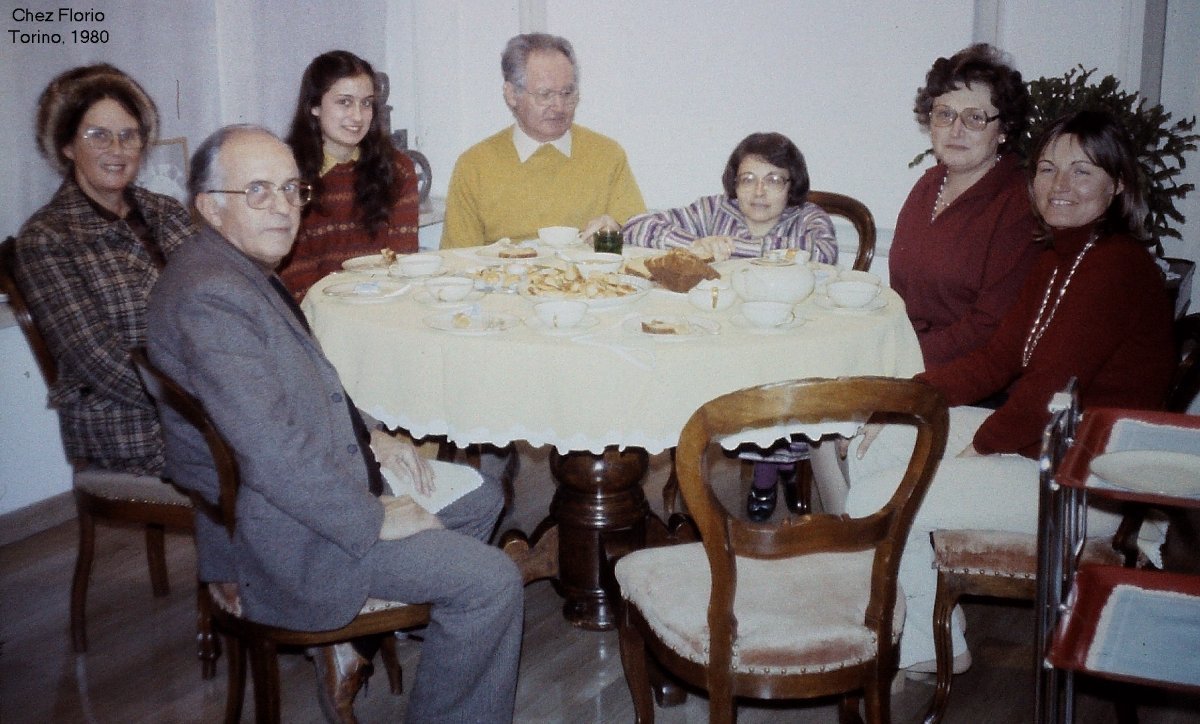Early Life
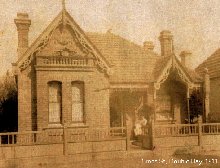
My parents were married at Orange in Feb 1910. My mother was born on a small farm at Byng near Orange. Hence the marriage was at Orange. She met my father through working in one of his shops. (My Uncles Percy and Carey also married girls who worked in their shops.)
My parents' first place of residence was in Cross St., Double Bay where Chattie was born in April 1911. They could only have remained at this address for about two years because I was born above one of their shops in Dec 1912. The shop was in Darling St., Rozelle, directly opposite the Rozelle Public School which I attended when I was 5. (I have a school photo in which I am holding the class flag, to prove it.)
I was not quite six years of age when World War I ended. One of my first memories was of seeing the photos in the newspaper of soldiers who had been killed in the war. I remember feeling frustrated because I could not read.
During the Great War (before I went to school), I used to accompany my father with his horse and cart as he made his deliveries around the city. One wet day on Pyrmont Bridge the horse slipped and fell, sending my end of the cart up in the air and I was thrown off onto the road, fortunately on top of a bag of chaff. I remember my father shouting: "Look after the boy! Look after the boy!" One passerby immediately sat on the horse's head while others unharnessed him, to prevent further damage. In those days, when everything was done with steam and horsepower, men were very familiar with horses. I remember admiring a man with a big waggon drawn by six draught horses managing to back the whole rig into a narrow loading dock in the city with only inches to spare.
Another day, a wheel came off outside Leichhardt post office (I could still point to the exact spot). It was getting dark, so my father unharnessed the horse and the two of us rode him home to Rozelle. I don't know how the cart fared but I presume there was nothing valuable left in it.
Before going to school, I must have been bored and one day went for a stroll down the street. I had beautiful big brown eyes (whatever happened to them?) and swarthy skin. A passing woman thought she would take me home to the Italian fruit shop where they informed her that I belonged to the lolly shop up the road.
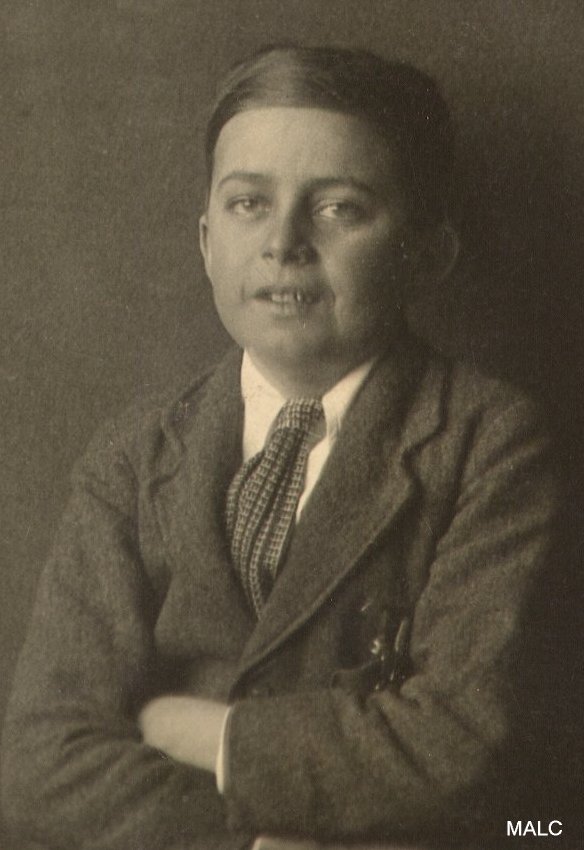
By the time I was 6, we were living with Grandma Lister in Day St., Marrickville. My mother had an extremely firm attachment to her family, and reconstructing things, I assume that Grandma and Grandpa Lister lived in this house with their youngest son Sid. Sid went to the war and was killed at the Somme in May 1918. Grandpa died soon after, and we must have moved in to keep Grandma company. [Thomas Sydney Lister died 8 May 1920. JC]
By 1920-21 we were in Unwins Bridge Rd, Undercliff, now called Bayview Ave., Earlwood. During these years I attended Marrickville West P.S. Our Moulder cousins lived nearby in Riverview Rd., fronting Cooks River. I remember fishing for eels there. Uncle Charlie had a garage at the intersection of Bayview Ave and Homer St. [Nina recalled going to Uncle Con's place for Sunday school. JCC] Uncle Charlie was a real character and even organised festivals on the river bank. Prize: a "real pig" for reaching the end of a greasy pole over the river. (The pig turned out to be a guinea-pig.)
The first shop the Kraushaars had was in George St., City, opposite where the Regent Theatre used to be. The area was called Crystal Palace then, I believe. By the time I was born, the main shop was in William St., Darlinghurst; they subsequently moved to 96 Oxford St., Darlinghurst. They had other shops in Leichhardt, Petersham, Newtown and Marrickville, as well as Rozelle. Maybe they still had the George St. and William St. shops too. I am not clear about this.
While we still lived in Sydney, my father used to leave early on Monday mornings with a full load of sweets, and return on Friday night with an empty truck after making deliveries all down the south coast. He spent his nights away in a room he rented from a Mr Street in Corrimal, about half way between Wollongong and Thirroul. (This is where Chattie later taught in the P.S. for some years.) I remember going with him one week at least, and staying in Street's back room. He (Street) was a returned soldier from WW1, and I remember polishing my boots (only women wore shoes), and my father saying "Don't forget the heels." Mr S said "A good soldier never looks behind him." He and my father became good friends, and when he began to make his own ice cream (he built his factory a couple of hundred yards along on a few vacant acres), Mr Street invited Dad to become a partner in the business (but 2 Cor. 6:14 got in the way).
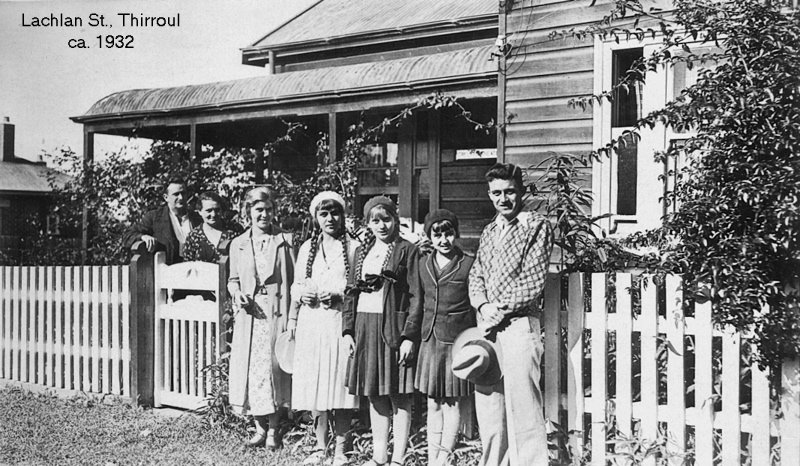
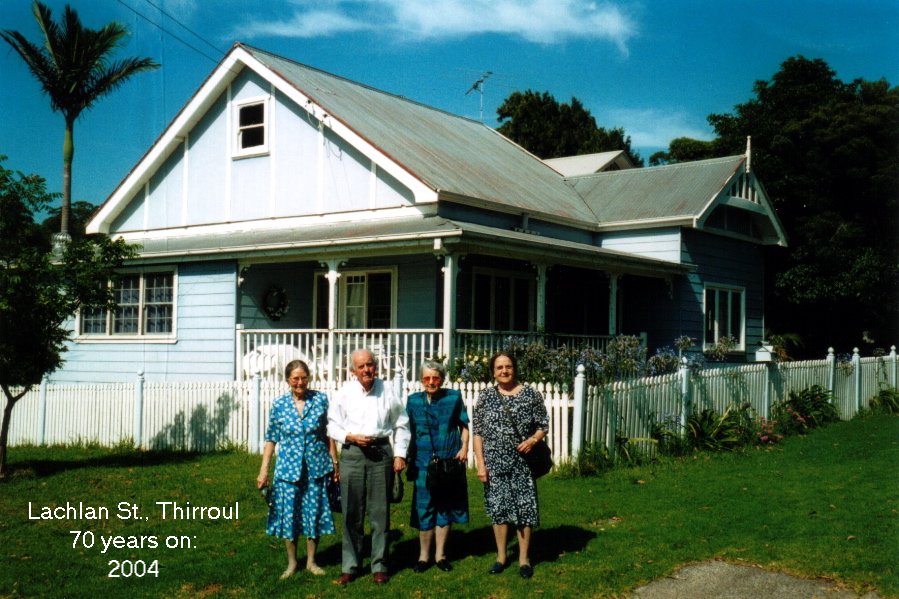
In Dec 1922 we moved to Lachlan St., Thirroul. My father left the Sydney shops and factory in the hands of his brothers and moved to Thirroul to facilitate distribution down the south coast. He claimed that it was the way I looked or spoke to him when he left each week that decided him to move down to Thirroul where there was a meeting. I was the only boy, and a bit of a favourite it seems. I remember going as far south as Kiama with him, and sleeping on the roof of the truck, where he kept the ice cream cones. And west as far as Katoomba. He was a little man with a big pioneering spirit. He loved farming. Like father, like son. We both stuck at jobs we hated (selling). We were both born with reserved and shy natures. I remember thinking my ideal job would have been a boundary-rider on a cattle station in outback Qld or NT, with a squillion hectares, living in a hut alone about 40km from the homestead, which I only visited once or twice a month for supplies.
I learnt to drive on my father’s Dodge truck [see photo; click to enlarge] at age 12. (He had previously had a T-model Ford.) I would sometimes travel with my father to Sydney, and after we reached the top of the Bulli Pass, I (from age 12) would take over and drive until we reached the outer suburb of Sutherland where there would be some traffic. The road was mostly unsealed except for a single lane of bitumen through townships and the same at Sutherland. We would rarely meet another vehicle. Vehicles in the 1920s were tough to drive. The steering, brakes and clutch were heavy and there was no synchro-mesh on the gears, which meant double-clutching for every change down.
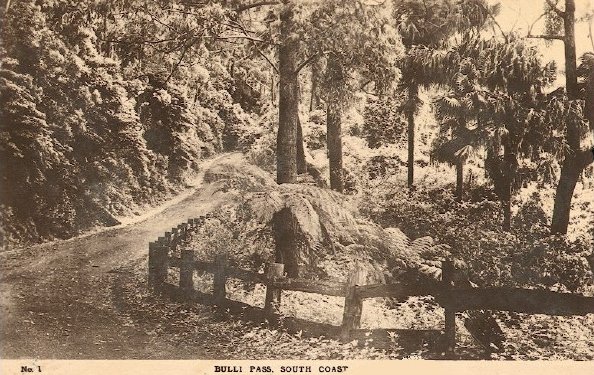
Coming back down the Bulli Pass with a full load was quite an adventure. Brakes were not what they are nowadays and sometimes my father would tie a tree-branch to the rear bumper as a precautionary measure.
Early Career
When we lived in Thirroul, I attended the local P.S. and Wollongong High School. After completing the Leaving Certificate in 1929, I qualified for my licence on my 17th birthday and, while spending six months looking for a career, I used to drive my father's Chevrolet truck, with its crude synchro-less gearbox, to Sydney and load it myself in Oxford St
My mother wanted me to be a doctor and I too would have liked that but this was at the height of the Depression and the family could not afford to put me through a long university course. My cousins Anice and Boydie (Alf) were busy finding public service jobs after their exams. Wondering about pharmacy, I went to Sydney in June 1930 to look around, and enquired in Pattinson's at 160 Pitt St. where I was received by Dr. Pattinson himself. He was very nice to me. He told me to go to Elliott Bros. in O'Connell St. and ask in the order room for "Mac" who "knew every chemist in NSW". Mac said there was a young fellow called Carter in Northbridge who was looking for an apprentice. I took the ferry from the Quay to Milsons Point, then the tram to Northbridge. By mistake I got off in Cammeray, so I walked over the bridge and up to the shops. At that time it was still the original suspension bridge that my father had seen being built as a boy [in 1892], I suppose while living at Folly Point [the tramway was added in 1914 but in 1939 the bridge started to sag at one end and the trams could no longer cross it, so it was reconstructed with a concrete arch. JC]. Carter was very deaf, perhaps as a result of serving in World war I. He offered me the job right away.
Thus I came back to Sydney in 1930 and boarded with my Uncle Percy and Aunty Emmie at 482 Mowbray Rd. West for four years while I did my apprenticeship.
I spent most of 1930 working full time (9am to 6pm) in the shop, and I used to commute between Lane Cove West and Northbridge by bicycle. Throughout 1931 and 1932, I had to attend Sydney University from 9am to 1pm five days per week, and be back at the shop by 2pm. I used to ride to Northbridge in the early morning, leave the bike at the back of the shop and catch a tram to Milsons Pt, then a ferry to the Quay, then another tram to the Uni. It was the time of deep depression, and money was scarce, and valuable. I think the fare was twopence from Northbridge to the ferry, and the same for the ferry ride, and the second tram. Coming back, I would leave the tram at Hunter St and walk to Elliott Bros in O'Connell St, and ask at the order room whether there was anything for the Northbridge Pharmacy. Then I used walk to Macquarie Place, where there was a beaut little Park, and there I would have my lunch. Then to the Quay, and back to the shop until 6pm, and then pedal home. Every day I would survey the work on the Bridge. There was a constant rat-a-tat-tat of the riveters. They built it from both ends, you know, and the big question arose whether the ends would meet. I believe it was only a few inches out!
I used to have Wednesday afternoons off and spent my time exploring in the city. When I was registered at 21, Carter ask me to become a partner. But I told him I could not be yoked with an unbeliever (2 Cor. 6:14). So we arranged that he would retire, we would splash "Under New Management" on the front, and I would work for half the profits. He was still the proprietor. I continued in that arrangement for many years, but when the war came I told him I wanted him out. So in about 1941, I bought him out.
From 1934 to 1938 I boarded in 4 Euroka St., Northbridge, just a couple of hundred yards from the shop. I then found a house at 4 Arkland St., Cammeray for my family to rent (they subsequently bought it), and I moved in with them for four years.
I had known the Johnstons and watched EMC (from about the age of 12) grow up into a tall, stately, beautiful woman, modest in her movements. I was quite infatuated and when she was 17½ I found an excuse to speak to her and asked her if she would marry me one day. At some point she replied by letter, quoting the last verse of the gospel of Matthew. (Not bad for a teenager!) I couldn't believe my luck! JKJ made us wait three years to be married and in the meantime would not let us go out alone.
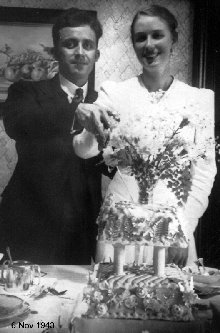
The Johnstons were a strange family who didn't understand the idea of sharing: black is black and white is white, what's mine is mine and mustn't be touched. Tom and Kerr would never say "our car" but "father's car". Thus Tom said of the Crawshaws: "What a nice family!" JKJ was a bit of a crackpot: he used to say "bread is better broken", i.e. not cut.
At the age of 27, M contracted encephalitis and was not expected to recover. Prayers were said at Ashfield for her. I used to go into the storeroom at the back of the shop and cry my eyes out, then go back and serve the customers. When she finally did recover the doctor said: "She now has every chance of reaching 50." Well, she's beaten that goal by 40 years so far!
After we were married, we lived over the shop for eight years (at 165 Sailors Bay Road, Northbridge), before moving to 23 Weemala Rd. After being there for 14 years, we were moved by the beloved brethren to 30 McHatton St., North Sydney, where we are to this day.
World War II
I had three encounters with the authorities over the war.
The first was a call for my age group (26) to be and appear at their HQ in Carlow St., North Sydney. We just had to fill in forms, and be weighed and measured. The next was a one-on-one interview at the same address. Those in charge were all-powerful and real dictators. The officer asked me what proof I had that I was a pharmacist. I told him to pick up his phone and call the Pharmacy Board. He hit the roof that an upstart like me should tell him what to do! So I had to get a copy of my registration from the PB and take it to him. He then said they did not need any more pharmacists and to go back to my shop and they would let me know if they wanted me.
It just so happened that at that time I had cast in my lot with the EBs, and was required to apply for objection to military service for conscience' sake. Thomas Heaney was one who was in my group, and he insisted on getting a barrister who charged us each 10 pounds, and did nothing. Ten pounds was nothing to TH, but it was a lot of money for me. I told them I was prepared to help the government in any way other than taking up arms. That seemed to please them. When the Captain asked TH what he would do if the enemy presented themselves at his factory door, the silly fellow said he would confront them "with his body"!
Pharmacists were taken in as lieutenants. Doctors and dentists as captains. I thought it would be interesting to work in a field hospital behind the front line, and hob-nob with the doctors and learn their trade, with a view to doing medicine when I came out. But I was doomed to a dreary life of hard work and frustration in that shop for 35 years.As an aside, when my age group came up, my boss, Ralph Carter, panicked and wrote a letter to the authorities, telling of his dependence on me, and signed it Edward Kelly. To this day I don't know why he did it. They could have easily checked and found it was false. He was a returned soldier from the first WW, and I expect it was just his way of showing his contempt for the system.
1949 Voyage
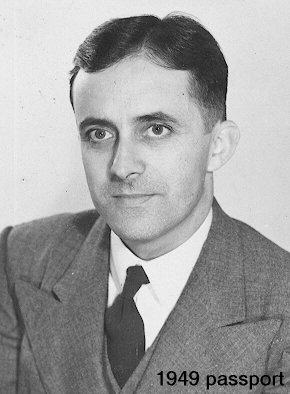
In 1949 Wallace Alderton offered me a "free" trip overseas. He owed me money and through some arrangement with John Jamieson (Mary's brother), who lived in Hong Kong and owned an ex-war Dakota [Douglas DC-3], this was his way of repaying me.
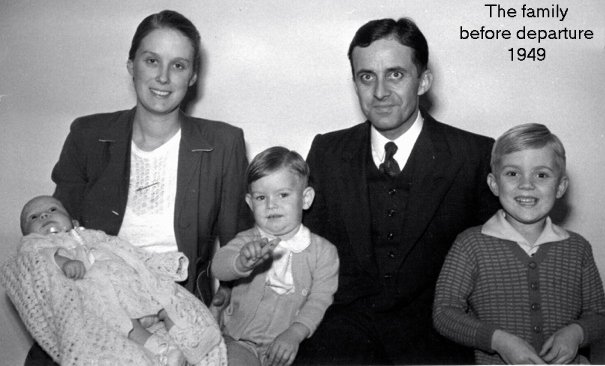
M was not at all pleased to be left with three small children. Vera Cope came to stay with the family.
The plane was a veteran, and needed some work done on it before we left, although the Pratt & Whitney engines were renowned for reliability. But the self starter seemed to be faulty. The crew consisted of a war veteran pilot who was a ruffian, and a much nicer younger man. One job the young fellow had to do was to turn the propellers to start the engines!
When we left Sydney, we had three passengers. A Professor, Mary Jamieson, and Yours Truly. The prof sat with me, Mary by herself, a bit stiff and distant. The prof called her 'demure'. Pretty brave I would say, to take on a trip like that on her own. She was then 29 years old.
On this epic journey our first stop for fuel was Cloncurry. Next was Darwin. Then some tiny island in the Arafura sea, the name of which I never knew. It was just a war-time strip cut out of the jungle. All I remember was the huge tray of eggs we left them. Seemed to be only two men there. Our next stop was Manila, where we spent a night, then Hong Kong, where we spent two nights, and picked up a load of ex-pat Swiss, to take home. That was the purpose of the exercise.
Mary J's courage seemed to fail in HK. She asked me to go with her on a harbour cruise. The prof talked a lot, mostly about beer. He kept saying "I crave beer," so in HK he shouted me drinks, glad to have a drinking partner. In HK I was determined to have a ride in a rickshaw, but the driver turned out to be a tout for prostitutes. Even in the hotel they asked me if I wanted a woman to keep me warm! And this was 1949. What must it be like in 2011?
The plane was badly overloaded. The professor and I had to go into the cockpit to put more weight on the front. I had to hold a lever on the floor. They said it was the throttle, a rather sensitive instrument for a novice in a take-off. The trouble was, the runway was very short, with a mountain at the end of it, and the ocean on either side. The fact that I am writing this is evidence that we made it, and quietly glided down the peninsula to Hanoi. The only map they had was like an atlas. Hanoi airport then was a derelict place. The French had just been kicked out, or were in the process. Our next stop was Rangoon, then Calcutta and Delhi. The prof was very annoyed that the pilot made no effort to fly over the Taj Mahal, even when we were so close. I guess the pilot had never heard of it. From there we flew to Karachi and Bahrain Island. Mary was to visit to her sister in Cyprus, so we had to land in Nicosia; thence on to Rome and Mulhouse, our terminus. In Rome, the prof and I had a night tour in a horse drawn carriage!
At Mulhouse I was able to get the last room in a nice little hotel - in the attic. Suited me fine.
In the morning (Sunday), I asked the girl at the desk if she could possibly phone a Hans Rellstab for me in Zurich. She asked if I knew his wife's name. It made it easier to find him in the phone book. Good idea? And what did I want her to say to him? I said: Ask him if he speaks English, and would it be acceptable for him if I came and spent the day with them? After a while, she said the answer was yes to both my questions. So I caught a train, and spent a very happy day in Zurich with Hans and his little meeting. He was an extremely nice brother. I felt quite drawn to him.
Back to the attic, and the next day I caught another train to Paris, and Calais, and a ferry to the white cliffs of Dover. You can't imagine the thrill it was for me to see these places of which I had heard so much.
Another train up to London, where I was met by no less a person than Alan Price. Bradman's "Invincibles" had just completed a whitewash of English teams, so he drove me past the Lords Cricket Ground. Although he was such a big-wig among the brethren, he was just as interested as I was in the game. He drove me to the place in North London (St Albans?) where I was to stay for the 3-day meetings with JT in London. The host's name was Joyce, a cousin of Cecil, who was also there.
I had arranged in Sydney to pick up a Vauxhall car in London after the meetings, so I trained it back, picked up the car, and drove to Leamington Spa, where Chattie was staying with the Eric Freemans. Then we picked up Freda Kennard somewhere, and I drove these two ladies to 3-day meetings with JT at Bristol, Glasgow, Edinburgh and Birmingham.
I should mention that food rationing was still in force in England, so I had taken a suitcase full of tinned meat etc., as much as I could carry. I was a quite welcome visitor as I dispensed this stuff.
Another thing was the terrible destruction the German bombs had wrought. One heap of rubble in central London that used to be a Bank, had a notice on it "This is nothing. You should see our Berlin branch." So it was two-way traffic!
At the end of this tour, I took the car back to the agents, and they put it on a ship, and I picked it up in Sydney - all arranged and paid for here.
In the meantime, I went to Southampton and caught a ship to New York where I had arranged to spend a week with Arthur Lyons, a wild Irishman with a past, who worked for the Taylor Linen Co. as a salesman.
On the Sunday, JT kindly asked me to spend the day with him. With all these privileges I have enjoyed, I should be a much better man than I am. One thing I will tell you about JT, he didn't believe in prohibition. He had a bottle of beer at each corner of the table. He said "It is very light. It won't hurt you." JT's second wife was a Miss Brown from England. His first wife had died in childbirth in 1900, giving birth to none other than JT Jr!
Miss Brown was largish and motherly and a bit garrulous. She told me she wanted something English in her NY house, so she had bought a British washing machine. A small one, that would take one of James's linen suits that he wore in the summer.
Arthur drove me to the HQ of The Taylor Linen Co., pointing out Wall St's notorious Stock Exchange on the way. Even in that day things were very quiet. Jim Taylor was there, talking to a client I suppose. But the shelves were mostly empty, and the place was like a morgue. Years later I asked Jim how the business was going, and he said "What business?" He said TV and the habit of casual eating had sounded the death knell of starched linen tablecloths and serviettes. The modern demand was for colourful tea towels etc., and Ireland could not supply such things. He had to go behind the Iron Curtain to get them.
After NY, I caught a plane to Toronto, where another nice family met and accommodated me. They suggested I take the famous train to Vancouver, through the mountains and the snow, by way of Banff. In Vancouver yet another brother took me under his wing, and after a couple of days put me on another plane to San Francisco.
You can imagine a lot of detail entered into such events, but I spare you - and myself!
I don't remember any brethren in SF. I know the plane was Pan Am, with four propeller engines (very noisy), and, by the time we got to Fiji, the wing flap brakes would not release. The pilot had to get permission to proceed in spite of the fault. So they cut down trees to lengthen the runway, and the fact that I am writing this proves that we arrived in Sydney unharmed (September 1949).
1954
The details of this trip can be documented elsewhere.
We flew to Melbourne where Uncle David Johnston delivered all six of us (including Hope) to the wharf. Our first port of call was Fremantle, then perhaps Aden and through the Suez Canal to Venice. Thence the train to Paris and Calais and the ferry to Dover.
The Vauxhall Velox we bought was a good car. It carried six passengers with a roof-rack and averaged 30 mpg. On our return, whoever was driving it from Woolloomooloo to the shipping agent's offices managed to have an accident, so we were without the car for some weeks - a terrible nuisance.
1958
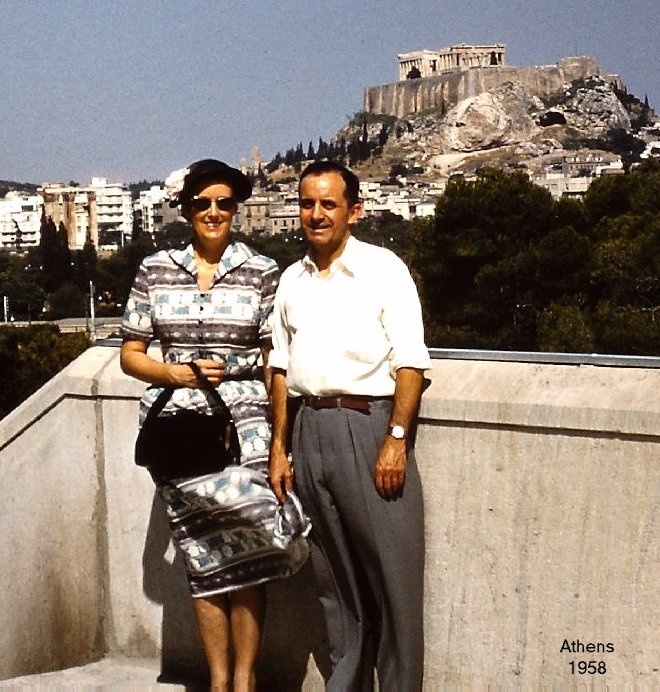
In 1958 (I was always glad to get away from the shop, the farther the better), M and I drove around the Continent of Europe for five weeks.
There was a brother in London by the name of Rollins, a car-dealer whom I used to call Robbers because of the deals he made. We purchased a very comfortably-appointed Bedford camper-van from him and drove straight to Dover to take the Calais ferry. The first thing that happened was someone smashed the driver's-side wing mirror on the ferry. Being British, the vehicle was unreliable. First the windscreen wipers ceased to function (we had AA assistance that resolved that), then the horn wouldn't work. M shared the driving, though she does not now remember it.
From France, we drove into Belgium, the Netherlands and Germany. In all my travels, there are two places I am most disappointed in not seeing: Berlin and Timbuktu. In Hanover in those days, the rules were, one had to get a permit to travel along the corridor to Berlin. We arrived in Hanover on a Saturday morning. I found the office, and there was a sign on the door that they would not be open again till Monday. We had a lot of ground to cover, and could not wait. So that was the closest I got to Berlin. It was a very different place in 1958 from what it is now.
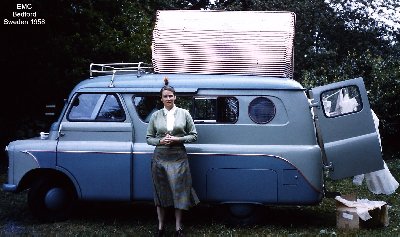
We then drove north into Denmark and Norway (I particularly remember the varm pølse, or hot dogs). Crossing a bridge into Sweden, we had to switch to drive on the left-hand side of the road. [Sweden changed to driving on the right on 3 September 1967. JC]
On our way south, we drove through Luxembourg and Switzerland, into Italy (I don't remember how far south). Then back through France to England. Because we were to attend three-day meetings in Exeter, we took a ferry that brought us directly to SW England [e.g. St. Malo or Cherbourg to Portsmouth? JC] There, as fate would have it, we were billeted with a local chemist. Percy Lyon (PL) was at the meetings but didn't want to know us, even though he was some sort of relative of the Johnstons. We were pretty disgusted with him.
We didn't wait till the end but left on the third day to race back to London, sell the van (not to the Robber; I don't know how we did it in such a rush) and board the plane for NY.
I think that was the year we attended special meetings with Bruce Hales in LA. I piped up in the first reading, and took him by surprise. "What are you doing here?" So afterwards he introduced me to many locals, and some of the glamour rubbed off on to me! The couple we stayed with were very nice to us. He was a clever bloke. He had invented a way to write on awkward surfaces like pens and pencils. He had to go to San Diego on business while we were there, and took us with him. I remember walking over the border, just to say we had been to Mexico.
We must have flown home from LA.
We were surprised to see how tall S had grown in the meantime.
1960
I went overseas again in 1960. My companions were Dick Pridham and Frank Heaney.
Our first call was Teheran in what was Persia in those days. There was a small meeting there of a simple few. Instead of trying to encourage them and shepherd them, these two blokes bullied them. I was disgusted.
The next stop was Frankfurt. I had arranged beforehand to pick up a car at the airport. Because it had a radio, the legal eagle Dick had to take off the aerial, and put a large piece of sticking plaster over the controls on the dashboard, leaving it to me to try and explain when I returned the car.
At Frankfurt we picked up Alan Gadsden from Melbourne and Douglas John from Adelaide. Then we followed Jim Taylor Jr around Germany for 12 days. Douglas was a professional painter, and at Wuppertal (where they have an overhead railway that hangs over the river) he saw the rust and said he would love to have the contract to paint it. Dick had lived in Germany for a year during his Uni days, and he thought he could speak the language, but I got on better with English. Where we were billeted we could hear Dick and others shouting to try and make the locals understand them.
We flew from Frankfurt to Manchester. Jim T refused food on the way, but kept drinking double whiskies. At Manchester we were met by brothers in hard hitters [= bowler hats JC] and a nice young fellow named Fysh from Melbourne [a nephew of Sir Hudson Fysh, founder of Qantas JC].Later Trips
We had further trips in 1967 (with MA), 1973 (with MA), 1980 (with MA, when we visited JC in Raccone, San Raffaele Cimena), and 1990 (our last trip, when we visited JC at the Poggio in Castagneto Po).
